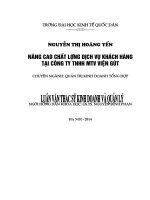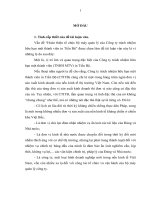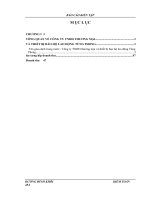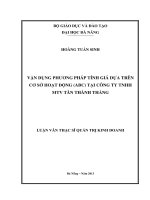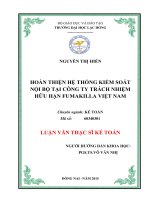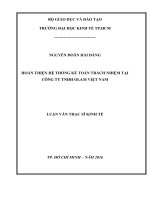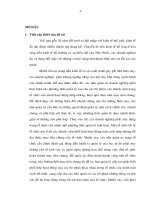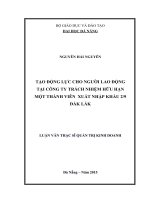Luận văn thạc sĩ tạo ĐỘNG lực CHO NGƯỜI LAO ĐỘNG TẠI CÔNG TY TNHH MTV vật tư ĐƯỜNG sắt đà NẴNG e
Bạn đang xem bản rút gọn của tài liệu. Xem và tải ngay bản đầy đủ của tài liệu tại đây (666.96 KB, 93 trang )
INTERNATIONAL EXECUTIVE
MASTER OF BUSINESS ADMINISTRATION PROGRAM
THESIS
EMPLOYEE MOTIVATION AT DANANG RAILWAY
MATERIAL ONE MEMBER COMPANY LIMITED
S e p t e m b e r, 2 0 1 3
i
ACKNOWLEDGEMENT
Firstly, I would like to express my deeply thanks for all lectures, professors
who have supported, created favorable conditions for me learning, studying,
transferring knowledge and sharing experiences during the last time.
I would like to thank Dr. Dang Ngoc Su for his enthusiast and great support to
provide guidelines for me to complete my thesis.
I also would like to give my special thanks for my leaders, colleagues in DRMC
who have created favorable conditions in the data collection to complete my thesis.
Althought, I have tried all my best to complete the thesis, there still have many
shortcomings. Therefore, I would like to received valuable comments given by the
relevant lectures
Danang, Oct 2013
ii
TABLE OF CONTENTS
ACKNOWLEDGEMENT.......................................................................................ii
DECLARATION...................................................................................................iii
LIST OF ABBREVIATION.................................................................................vii
LIST OF CHARTS..............................................................................................viii
LIST OF CHARTS................................................................................................ix
INTRODUCTION..................................................................................................1
CHAPTER 1: MOTVATION THEORIES FOR EMPLOYEES........................4
1.1 Roles of motivation for employees...............................................................4
1.1.1 Motivation and create motivation for employees.....................................4
1.1.2 Roles of motivation to the productivity of employees..............................5
1.1.3 Factors influence to the work motivation.................................................6
1.1.3.1 Intrinsic factors..................................................................................6
1.1.3.2 Extrinsic factors.................................................................................9
1.1.4 Motivation theories................................................................................10
1.1.4.1 Hierachy of needs by Maslow..........................................................10
1.1.4.2 E.R.G theory by R.Alderfert............................................................12
1.1.4.3 Need (content) theory continued by David Mc. Clelland.................13
1.1.4.4 Positive reinforcement by B.F.Skinner............................................13
1.1.4.5 Expectancy theory by Victor Vroom................................................14
1.1.4.6 Equity theory by J. Stacy Adams.....................................................15
1.1.4.7 Two factor theory by F.Herzberg.....................................................16
1.1.4.8 Goal theory Edwin Locke................................................................17
iii
1.1.5 Summary of basic factors influence to the motivation work in these
abovementioned theories.................................................................................18
1.2 Content of motivation work in the enterprise...........................................18
1.2.1 Define needs of the employees...............................................................18
1.2.2 Develop and select the way to create motivation....................................19
1.2.2.1 Build the equitable and appropriate salary system...........................20
1.2.2.2 Build appropriate reward system.....................................................20
1.2.2.3 Build attractive welfare system........................................................21
1.2.2.4 Training and develop human resource to increase adaptability of
workers with the development of the working environment........................21
1.2.2.5 Create good working environment and conditions...........................22
1.2.2.6 More concern about the development and growth...........................23
1.2.2.7 Corporate culture.............................................................................24
1.2.3 Assess the satisfaction level of employees in the enterprise...................24
1.3 Rationale to create motivation for employees in DRMC.........................25
CHAPTER 2:
THE SITUATION OF THE MOTIVATION WORK FOR
EMPLOYEES IN DRMC....................................................................................27
2.1 Overview DRMC.........................................................................................27
2.1.1 Overview................................................................................................27
2.1.2 Scope of operation..................................................................................27
2.1.3 Business strategy....................................................................................29
2.1.4 Organizational structure.........................................................................30
2.2 General characteristics of the human resource of DRMC.......................33
2.2.1 Gender structure in the company............................................................33
2.2.2 Labor structure by age in the company...................................................34
2.2.3 Labor structure by education background..............................................34
2.3 Business performance in the DRMC.........................................................35
2.4 Motivation works for employees in DRMC..............................................37
2.4.1 Findings from motivation survey in the last time...................................37
iv
2.4.2 Motivation work situation in the DRMC................................................40
2.4.2.1 Salary...............................................................................................40
2.4.2.2 Reward and welfare works..............................................................45
2.4.2.3 Working environment in DRMC......................................................49
2.4.2.4 Training in the DRMC.....................................................................51
2.4.2.5 Promotion and development opportunity in the company................56
2.4.3 Overall assessment of the motivation in DRCM....................................57
CHAPTER 3: SOLUTIONS TO MOTIVATE EMPLOYEES IN DRMC THE
PERIOD 2014 TO 2017........................................................................................60
3.1 Objectives and directions on development of DRMC..............................60
3.1.1 Development objectives of DRMC in the future....................................60
3.1.2 The direction for development of DRMC...............................................60
3.2 Viewpoints on creating motivation for employees at DRMC...................61
3.3 Solutions to improve the motivation in DRMC........................................62
3.3.1 Improving method of determining the needs of employees....................62
3.3.2 Improving motivation for employees.....................................................63
3.3.2.1 Improving the job analysis:..............................................................63
3.3.2.2 Improving the annual performance appraisal...................................65
3.3.3 Improving salary policy..........................................................................66
3.3.4 Improving the recognition and welfare policy........................................67
3.3.5 Improving the relationship between leaders and staffs...........................68
3.3.6 Training and building future team leaders..............................................70
3.3.7 Annual plan and execution for 2014 – 2017 period................................71
3.3.8 Total plan evaluation..............................................................................73
3.4 Recommendation........................................................................................73
3.4.1 Recommendation for the Labor union:...................................................73
3.4.2 Recommendations for the management team:........................................73
CONCLUSION.....................................................................................................75
REFERENCES.....................................................................................................76
v
LIST OF ABBREVIATION
Abbreviation
VNR
DRMC
In full word
Viet Nam Railway
Danang Railway Material One-member Company Limited
vi
LIST OF CHARTS
Page
Table 1.1 two factors theory by F.Herzberg.............................................................16
Table 2.1: Employees by gender in the company....................................................33
Table 2.2: Labor structure by age in the company...................................................34
Table 2.3: Revenue by service of the company........................................................36
Table 2.4: business reults of the DRMC in 3 year (2010 -2012)..............................37
Table 2.5: Assess the satisfaction level by gender and age......................................39
Table 2.6: List of individual and department for the best performance in 2012.......47
Table 2.7: Welfare of DRMC...................................................................................49
Table 2.8: Training results in DRMC.......................................................................54
vii
LIST OF CHARTS
Trang
Figure 1.1: Maslow hierarchy of needs................................................................11
Chart 1.1 Victor Groom Model................................................................................15
Chart 2.1: DRMC organization chart.......................................................................30
Chart 2.2: Labor structure by education background from 2010-2012....................34
Chart 2.3: Labor structure by education background...............................................35
Chart 2.4: Assess level of complicated work...........................................................38
Chart 2.5: findings on the wage satisfaction............................................................45
Chart 2.6: Factors impacts to the work effectiveness...............................................47
Chart 2.7: The satisfaction in the working environment..........................................50
Chart 2.8: Training at the company.........................................................................55
Chart 2.9: Development opportunities.....................................................................56
viii
INTRODUCTION
1. Rationale
Danang Railway material one member company limited (abbreviated as
DRMC) was established in 1978, is an independent company of the Railway
Construction Corporation. After more than 30 years of development, the DRMC is
considered as the leading company in providing materials and supplies, machinery
and equipment of railway industry.
Human resources is a key factor in determining the success or failure of the
enterprise. Especially in the context of globalization and international economic
integration is going very strong, the competitive environment is increasingly fierce
among enterprises both at home and abroad that requires enterprises to build their
high quality workforce, effective performance to promote the strengths of the
business to gain competitive advantage in the market.
To survive and develop in the free market economy, the enterprise is always
towards to the production and business with the high quality and efficiency, and to
achieve that goals, the human resource is the core element. Follow to this
determination, enterprises are looking for the best solutions to have effective usage
of their human resources. However, how to arouse the enthusiasm of workers, using
reasonable and effective exploitation of human resources in business is a very
important issue. Therefore, solution to improve the motivation for employees to
dedicate their capabilities for the enterprise is essential.
In recent years, the company has tried to create motivation for their
employees. However, the motivation for employees still have some shortcomings.
On the other hand, motivation is required to adapt to the regular change of the
working environment. So, the author has selected the topic for the thesis
"Employee motivation at Danang Railway Material One member Company
Limited known as DRMC".
1
Research question
Do employees in the DRMC currently have their real motivation in performing
their works or not? If yes, what level do they have?
In reality, do the company leaders have their right perception to the content and
important of the motivation and for what level?
What actions and methods are being taken by the company leaders to improve
motivation for employees? Are they suitable with employees?
What are current shortcomings in creating motivation for employees in the
company as well as the causes of these shortcomings? What are the root causes?
What are essential solutions for improving motivation to get higher results in
the upcoming time?
2. Purpose and applicability
Systemize
motivation
theories
for
employees
in
enterprises,
and
organizations.
Analyze and assess the motivation situation for employees in DRMC,
finding the root causes to limit motivation for employees in DRMC.
Propose solutions to improve motivation for employees in the DRMC
3. Subject and research scope
+ Research subject: The motivation for employees in the enterprise
+ Research scope:
Scope: Only DRMC is studied.
Time frame: The motivation situation for employees in the DRMC
implemented from 2010 to 2012 will be studied. Recommendations and solutions
for improving motivation for employees in the DRMC will be proposed for the
upcoming time from 2014 to 2017.
2
4. Research method
4.1 Research method
To follow the research objectives, the qualitative and descriptive analysis will
be used in this research.
4.2 Data analysis and collection
+ Data:
Primary data: It will be collected through interviews and questionnaire survey
Secondary data: It will be collected from books, referent books and internet …
+ Data process: The collected data will be processed by the Excel and computer
5. Contribution of the thesis
The thesis will systemize theories on the work satisfaction, factors influencing
to the employee’s satisfaction; analyze the motivation situation in the DRMC;
analyze factors influencing to the encouragement and satisfaction of employees.
The important results of the thesis is to propose solutions to improve employee’s
satisfaction to improve the work performance for employees.
6. Thesis structure
Beside the introduction, content, conclusion and reference, the thesis structure
will have three chapters
Chapter 1: Motivation theories for employees in the enterprise.
Chapter 2: Analyze the motivation situation for employees in the DRMC
Chapter 3: Main solutions to improve the motivation for employees in the
DRMC
3
CHAPTER 1: MOTVATION THEORIES FOR EMPLOYEES
1.1 Roles of motivation for employees
1.1.1 Motivation and create motivation for employees
Any organization would expect their employees to complete tasks with high
efficiency to contribute to the successful implementation of the objectives of the
organization.
However,
there
are
many
employees
who
always
work
enthusiastically with effective performance, there are also sluggish workers, lack of
interest in work , neglect of work, or even quit, job performance is low
Many economists have pointed out that the answer to the abovementioned
problem is the work motivation of individual employee. There are many different
approaches to the nature of the labor force
“Motivation is the desire and willingness of individuals to enhance efforts
towards to the achievement of organizational goals”.
“ The motivation of the employees is the internal factors stimulate efforts in
the normal working conditions enabling the productivity and efficiency”2
Expression of motivation is the willingness of effort, passion to work to
achieve the goals of the organization as well as their own.
Maier and Lawler (1973) presented the model of work performance is a
function of ability and motivation. While, the working ability depends on innate
ability, knowledge and skills are gained through working experience and training;
resources to do the job. Motivation is the desire and voluntary of each individual.
From these abovementioned studies, it could be understood: "Motivation is the
internal factors stimulate individual efforts to work with the voluntary desire and to
achieve their own goals and objectives of the organization "
Work motivation is the process to create motivation of individual employee in
working. Therefore, create motivation is understood as the application of policies,
Associate Professor Ph.D. Nguyễn Ngọc Quân and Master Nguyễn Văn Điềm ( 2004) HR Curriculum
publishers society Labor pages 134.
2
Ph.D Bùi Anh Tuấn ( 2003) Organizational Behavior Curriculum Publisher Statistics pages 89.
4
solutions, and the appropriate management tools influence to employees to make
their motivation in working thus promoting satisfactory with their work, the desire
and effort to work better to contribute to the organization.
Work motivation for employees is the complex process. At the management
perspective, it is the manager's impact generates the motivation of individuals.
There are two types of impacts:
Firstly, worker is forced through the economical solutions and economic
coercion economy. These actions taken place in the regime of private property is the
most significant period of capitalism. Today, it is not widely applied
Secondly, workers are stimulated through incentives for both matter and spirit
to create motivation to work. This second type of impact is now widely applied in
many organizations and businesses.
1.1.2 Roles of motivation to the productivity of employees
Motivation is expressed through specific tasks that each employee is currently
responsible and with their attitude with the organization. This means that there is no
general motivation for each employee. Each employee may have different
motivation to work harder. Thus, motivation is associated with the job, an
organization and a specific workplace.
Work motivation does not entirely depends on the individual personality traits,
it often change depends on the objective factors in working. At this time, an
employee may have high motivation to work but the motivation is not always
existed at other point of time.
Work dynamics is voluntary and depends on the workers themselves, they
work actively and work harder when they do not feel a pressure or pressure at work.
They can achieve the highest productivity when working in a voluntary initiative.
Work motivation plays an important role in increasing the productivity of
while the other input conditions remain unchanged. Motivation as an internal
invisible labor force push labors to worker enthusiastically. However, the
motivation is the only source to increase labor productivity rather than conditions to
5
increase productivity because these depend on the qualifications and skills of
employees, the technology of production lines.
To get motivation for employees, it must find ways to create the motivation.
Thus "motivation is the system of policies, procedures and management practices
impact to employees which is aimed at to get employees motivated to work."
In order to create motivation for employees, it needs to understand the working
purpose of employees so that motivation and work dynamics are created for
employees.
1.1.3 Factors influence to the work motivation
Motivation of employees is not natural appearance which is a combination of
resources and belongs to the employees themselves, living and working
environment of employees. Thus, the dynamic behavior of the employees in the
organization is affected by many factors and can be divided into two groups as
follows:
1.1.3.1 Intrinsic factors
The job description
Employees will be interested, motivated to work when they are appointed to
match with their capacity, have the opportunity to use their knowledge and skills in
work, independent in work and receive feedbacks on the results of work, and have
benefits to complete assigned work. However, along with long time of working, the
job becames familiar with the work, repeated tasks will create boring and leads to
reducing the destructive motivation of employees. So, to ensure the work creates
excitement for employees, managers need to pay attention to the analysis and
design of job description that has been specifically designed, challenging,
responsibilities must be clearly defined, appropriate working arrangements with
competence, excellence of employees so that they can maximize capacity.
Technology
6
The technology knowledge is significant impact to the motivation of
employees. The advanced techniques and modern technology requires employees to
have advanced knowledge to meet the job requirements. This promotes employees
strive to learn, explore advanced skills to be able to survive and development or
they will be eliminated. As a result, enterprises should also pay attention to provide
trainings for their employees, advised knowledge, skills need to be trained in
accordance with the technical specification and technology of the company.
Working conditions
Working conditions include factors such as equipment and facilities, the
organization and workplace arrangement, the hygiene factors (dust, noise ..), the
work cooperation have a significant impact on the ability to work, health, work
attitude and work performance. If the employee is working in good working
conditions such as fully equipped facilities, work is arranged logically organized,
modern production methods applied offer higher productivity, reduced the heavy
work, labor safety and health protection of workers, the healthy and belief of
cooperation spirit... will make employees feel comfortable in working to promote
higher productivity and vice versa. Therefore, managers must pay constant attention
to creating favorable working conditions for their workers eager to work.
The management and leadership style: In the organization, the leader is the
person directly managing and directing employees so the management style has
great influence on the attitude and outcomes of their staffs. Currently, leadership
and management style can be divided into three categories. Paternalistic(Autocratic)
leadership style is autocratic leaders make decisions and get employees to comply
without any question, it is usually created stressful for employees, employees work
as a the machine, there is no work motivation, however, this style promote
efficiency in emergency situations where it needs to have quick decisions, resolute.
Democratic management style leaders are interested in attracting employees in the
decision making process, consultation is made to have the final decision, this style
is to create a spirit of cooperation, but sometimes it will be making difficult as well
7
as delays in decision making if indecisive leader. The laissez-faire style, the leader
increased autonomy for subordinates by allowing subordinates to make decisions
and reduce the cost of intermediate management, however if subordinates have no
capacity and commitment with the organization, they will bring damage to the
organization.
Each leadership style has its advantages and disadvantages so leaders need to
determine the appropriate style to encourage employees to achieve the organization
goals.
Corporate culture
Corporate culture is created from the overall objectives, policy management,
human relations, working environment, working style, the material and symbolic
e.g. songs, uniform, forms, norms ... create identity, values, beliefs, lifestyles and
ways of action and attitude and behavior of employees. Enterprises that have their
own strong corporate culture will help members to close together, mutual
understanding, independent working, friendly cooperation to achieve goals of the
organization
The human resource management policies: including all aspects from
recruitment, human resource arrangement, staffing, job appraisal, training and
development of human resources, compensation, health and safety policies have a
large impact on the work motivation. The timely and appropriate human resource
management policies is not only help managers having an effective way to achieve
the goals of the organization, but also to ensure the rights as well as expectation of
employees that affect to the motivation of employees. If the worker is working in a
safe environment, get high payment that is appropriate with their performance
result, having opportunities for promotion and learning, to be treated fairly, having
opportunities to promote their strengths ... they will have their commitment with the
company, try all their best to contribute to the company.
Organizational structure
8
The organizational structure is a system of tasks, relations, report and power to
maintain the operation of the organization. The organizational structure plays a
decisive role in all activities of the organization. A reasonable structure, simple,
power and responsibilities of each department and each member is clearly divided,
flexible, non-overlapping, in accordance with the requirements of the organization
will help perform tasks quickly, high effectiveness, and get employees understand
their position within the organization and from which they will actively and
commitment with their work. Conversely, if the structure is not appropriate, more
clues, more overlapping parts will lead to stagnation and inefficiency.
1.1.3.2 Extrinsic factors.
The position and role in society
Employees working in the industry that society interest and appreciation, they
will feel pride, love of work, effort at work. In contrast, for other fields that society
is less concern and appreciate, employees may not feel satisfy with the job,
employees is easy to be inferiority complex to take the job, they will disincentive to
work. Thus, to get motivation for employees, managers need to create excitement in
the work for the employees, to have psychological impact to their workers to really
appreciate and proud of the work that they are currently taking, while providing
solutions to improve the position and image, change the perception of society with
the career.
Laws of the State
Especially, labor law is the legal basis to ensure the rights and obligations of
the parties in the employment relationship. The strict legislation enforcement and
high effect of the law, employees are willing to work hard because their rights are
protected by the law. To do this, the State and other agencies have been researching
and perfecting the legal system to be more effectively.
The system of social welfare
9
The social welfare system have a role to ensure and support a part of life for
employees after retirement or due to occupational accidents, occupational diseases,
maternity. When the social welfare system is growing, the lives of employees will
be increasingly assured. When employees have the full of their social insurance,
they will feel more secure for their life after retirement, from which they will pay
more attention to their work, they will get high work motivation and efficiency.
The cultural values and national traditions
In European countries such as Britain, the U.S., the individualism is enhanced,
the individual will concern to their interests first and then to their relatives. They
regard the importance of self striving, to assert themselves by their capacity, so the
association and teamwork spirit is not high. While in the East, teamwork is highly
appreciated, cooperation desired, connection, support, and protect each other. This
difference affects to the spirit and attitude of employees. Therefore, it should pay
attention to aspects of cultural values and national traditions in developing the
policy of human resources management
1.1.4 Motivation theories
1.1.4.1 Hierachy of needs by Maslow
According to Abraham Maslow, the basic needs of forming the hierarchy of
needs, the innate need of human being is placed in a series of stages from primitive
to advance. 5 ladder of Maslow's needs is important invent as academic foundation
which is capable of very high practical applications that help managers developing
their leadership perspective for improving the management method.
10
Figure 1.1: Maslow hierarchy of needs
Physiological needs: It includes basic needs for human can survive like food,
water, clothing, shelter.In working, employees want to receive reasonable salary to
cover living activities and secure their lives and their families.
Safety needs: is needs to desire to be safety. Employees want to have the
stable work for long term, safety working conditions, adequate, sufficient safety
equipment/facilities and care to protect employees.
Social needs (belonging, love): employees want to exchange, meet and
establish contact and relationship with others in life and at work. At workplace, it
can be met through networking activities, teambuilding activities outside the
company, lunch, join the football team of the company, travel, vacation…
Self esteem: is the need for having good position in the society, respect from
others or recognize achievement, talent, capacity of individual. At the workplace,
the symbol of this status can be the needs to working in the large room, fully
equipped, rewarding achievement... because they show appreciation and recognition
given by the enterprise with the individual contributions.
Self actualization: is the highest level by the needs for honesty, beauty,
creative autonomy, desire for the comprehensive development of both physical and
intellectual. At the workplace, employees want to have challenge job, require
themselves to effort to achieve the goal, they want to freedom to work.
11
Maslow said that individuals in the organization mainly act on the needs and
satisfying their needs to their satisfaction and encourage their action. According to
him, the needs for human develops from low to high, the low level needs are
satisfied, then it is no longer essentially create momentum and higher needs will
become more powerful and decisive impact to the behavior of the employees. So, to
motivate employees, it needs to understand the current level of needs of employees,
then, taking measures is aimed at satisfying their needs to make them enthusiastic
and work harder, buoyed in working and more committed to with the tasks
simultaneously to ensure that the objectives of the organization is met.
1.1.4.2 E.R.G theory by R.Alderfert
E.R.G theory that human action is rooted from needs and pursuing to satisfy
three basic need at the same time:
Existence: it includes physical requirement for survival such as foods, water,
clothing, shelter and other basic needs for the body.
Relatedness: is the demand for relationships and interactions between
individuals in life and in work such as relationship with family members, relations
with supervisors, subordinates and colleagues at work.
Growth: is the need for personal development, is to create to maximize ability.
ERG Theory and Maslow's theory are similar to define hierarchy of needs, and
recognize human needs satisfied by from low to high. However, ERG theory has
reduced to three levels and it is more complicated to go to higher level, and a failure
to meet the high needs will create the drop in satisfied lower needs. So, when
individual cannot satisfy for the personal development, he will seek to return to the
lower needs and aims at to earn more money. So ERG model becomes less rigid
than the hierarchy of needs by Maslow, this means that each individual can flexibly
satisfy their needs depending on their abilities.
ERG theory explains why organizations find different ways to know where is
to stop at the hierarchy of needs thereby encouraging their participation in decisionmaking. Actual management has indicated that the involvement of provide
12
comments make employees feel that they have recognized and motivated them in
working.
1.1.4.3 Need (content) theory continued by David Mc. Clelland.
David Mc Clelland states that humans have three basic needs such as
achievement, affiliation and power.
Achievement is the human’s desire to overcome obstacles to achieve success in
work and in lives.
Affiliation is the desire to establish social relationship with others, the need of
mutual relationship, support and help each other.
Power is the need to control and influence to the working environment of
others, control and influence to others.
According Mc.Clelland persons with high achievement needs are often pursue
to have better resolution, wanting to fulfill individual responsibilities, set high goals
for them to constantly strive effort, demanding specific feedbacks, immediately,
want freedom to work. He also said that successful people in society and in the
business who have high in achievement, power needs and not too low affiliation
needs. Therefore, managers need to know of those who have high achievement
needs, given their important work, freedom in work and enabling them to develop
their capacity and provide feedback on the results of their work in a particular way,
adequate and timely so that it can effectively use capacity of these employees in
order to achieve goals
1.1.4.4 Positive reinforcement by B.F.Skinner
Theory of Skinner states that human will tend to repeat behaviors that they
are receiving positive (reward) for behavior that is not rewarded or fined will tend
not to repeat. However, the effect of the reinforcement such as reward and fine
depends on the interval between the occurrence of the behavior and the time bonus
or penalty, the shorter the period, the effective impact on the behavior will be
higher.
13
According to the theory, to motivate for employees, reward should be more
given such as praise, promotion, money to encourage the achievement, efforts of
employees that bring interest for the company. On the other hand, it should limit the
use of punishment as a rebuke, cut benefits for worker’s faults that have or may
have ignored, as not to know the error is temporary or not serious enough to require
to use punishment, give them opportunities for overcoming.
To be able to use these Punishments to encourage employees to work, the
enterprise must perform the following tasks:
Identify specific positive behaviors to guide employees in working at the
same time points out negative behavior that employees should not commit.
Build the punishment associated with the behaviors identified above, however
it should be emphasized in the form of reward rather than punishment.
To inform and explain employees to understand the good and bad behavior,
reward and punishment measures respectively.
The need to reward or punish conduct right after behavior taken place as soon
as possible and it must be conducted fairly, openly
1.1.4.5 Expectancy theory by Victor Vroom.
Victor Vroom has researched and formulated the individual motivation as
follow:
Motivation = Expectancy x Instrumentality x Achievement
Expectancy or relationship - achievement: is the ability that an employee
aware that a certain effort will lead to the level of achievement.
Relationship between achievements - reward: the belief that when the job is
done and achieved a certain performance, employee will be received a reward
commensurate
The attractiveness of the reward: the level of importance that employees place
on the outcome or the potential rewards that they can achieve in their work. This
catalyst means that there is appeal of both the target and needs of employees.
Vroom expectations theory indicates that an employees would have work hard
if they have a strong belief that a certain of their efforts will bring a certain
14
achievement, and they would be received the rewards or results as expected. Thus in
order to create motivation for workers eager to work, managers must make it very
clear that the relationship between effort and achievement, between achievement
and rewards, and rewards both physically and mentally in accordance with the
achievements of employees and especially is suitable to the needs, expectation of
the employees.
Chart 1.1 Victor Groom Model
1.1.4.6 Equity theory by J. Stacy Adams
According to Adams J.Stacy , employees in organizations always want to be
treated fairly including in and outside working place .
The internal equity means that employees expect to the accurate assessment of
their contributions to the business and receive salary, bonus, incentives and efforts
or contribution that they have spent. If employess think that what they are received
is not associated with their efforts that they have made, they will be frustrated , then
they will work without highest capacity or even they will be able to stop working. If
they think they get the deserved rewards and incentives they will maintain the
capacity, if they found that the reward and remuneration are higher than what they
want, they will work hard. But that will tend to reduce the value of long-term
rewards and no incentive effects.
15
External equity is that employees want to be treated fairly as others. Thus they
tend to make comparation of their benefit with their contribution with others
Individual benefit
Individual benefit
Other’s benefits
>=
<
Other’s contribution
Employees will think they are treated fairly when they know the rate for their
benefit above their contribution is equal with others then they will satisfy with the
work, their work will be effective. Otherwise, if the rate is not equal they think they
are being treated unfair they will have disgruntled behaviors, reaction to the fair
such as reduce the work effort, more absense or even resignation
Therefore, to establish and maintain fairness in the organization in order to
create motivation for employees to work , businesses need to build good evaluation
system , with the appropriate criteria, accurate and equitable evaluation method,
evaluation conducted fairly, and openly which is aimed at to accurately reflect the
performance and contributions of employees . At the same time conducting
salaries , bonuses and human resource activities based on the results of the
evaluation . In addition, it needs to avoid discrimination among employees in the
team for any reason such as gender, age , ethnicity or religion ...
1.1.4.7 Two factor theory by F.Herzberg
Frederick Herzberg has divided factors influence to the employees motivation
in to two following groups namely: Maintaining factors and Incentives factors.
Table 1.1 two factors theory by F.Herzberg
Maintaining factors (environment)
Incentives (Motivation) factors
Policy and management
Achievement
Work supervision
Recognize achievement
Salary
Internal/core responsibility
Working relations
Job responsibilities
Working conditions
Promotion
16
The extrinsic factors have the effect to maintain the status to maintain good
working, preventing dissatisfaction at work but do not make them do the job better.
Conversely, if it does not address it properly it will create resentment and reaction,
employee’s opposition thereby the performance will be reduced.
The incentive factors, if there are good resolved, will create work satisfaction
and will motivate employees to work harder, work harder, otherwise if it is not done
well, it will make employees dissatisfied with their work. Employees shall work as
required to achieve their work without excitement, depression, no motivation to
strive to improve of their performance.
Therefore, to create job satisfaction in order to provide incentives for
employees, first the manager should pay attention to maintaining factors prevent
dissatisfaction and create comfortable working conditions for employees. Next, to
impact of incentive factors to create motivation for employees to work through the
analysis to enrich the work content, increase challenges, increase liability, empower
for employees, express recognition of achievements of employees through increased
salary, reward, promotion and other remuneration.
1.1.4.8 Goal theory Edwin Locke
This theory states that intentions to work toward goal is the main source of
work motivation. Through his studies Edwin Locke pointed out that the specific
goals and challenges will lead to better job performance .
Thus in order to have motivation of employees, the following steps should be
taken:
Develop specific goals that are challenging and measurable as this will help
employees better understand the expectations of the organization, they will
determine what needs to be done to achieve goals . At the same time, employees
will work hard with the challenging goals.
Next, the manager needs let employees know that the set objectives are
reasonable, and achievable. To accomplish this it can be explained the goals set out
with employees, attracting them participation in goal setting process, assigning
17
